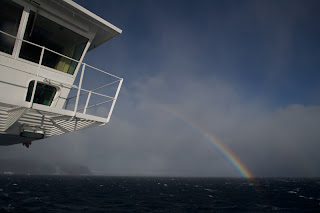The FRAM motored past Brown Bluff and through the spume and rainbows we could see the volcanic lava flows and the ash deposits of the bluffs. We continued eastward but conditions did not lessen and finally the decision was made to come about and begin our 2 day transit to South Georgia Island.
 Numerous large icebergs populate the waters north of the Antarctic Peninsula and today we passed by many. They break off the Larsen Ice Shelf in the Weddell Sea and are carried north and west by the ocean currents. When they break off the ice shelf they have the characteristic flat-top of ice-shelf formed icebergs. However by the time some of the smaller ones have drifted to the top of the Antarctic Peninsula the normal flat-top surface may be at a steep incline. This is the result of seawater melting them below the waterline and winds ablating some of the compacted snow and ice above the waterline. As a result of this differential melting and weight loss the bergs become unstable and roll or tip to unusual angles. Today we saw several where the former flat top surface is now inclined and the bergs appear as though they have been sliced through with a large knife. Some of the smaller bergs have melted and rolled several times, their shapes are indescribable but they are quite photograph-able.
Numerous large icebergs populate the waters north of the Antarctic Peninsula and today we passed by many. They break off the Larsen Ice Shelf in the Weddell Sea and are carried north and west by the ocean currents. When they break off the ice shelf they have the characteristic flat-top of ice-shelf formed icebergs. However by the time some of the smaller ones have drifted to the top of the Antarctic Peninsula the normal flat-top surface may be at a steep incline. This is the result of seawater melting them below the waterline and winds ablating some of the compacted snow and ice above the waterline. As a result of this differential melting and weight loss the bergs become unstable and roll or tip to unusual angles. Today we saw several where the former flat top surface is now inclined and the bergs appear as though they have been sliced through with a large knife. Some of the smaller bergs have melted and rolled several times, their shapes are indescribable but they are quite photograph-able.
New sights and animals are ahead as our next stop will be South Georgia Island. Antarctica is now behind us but the vistas, the penguins, the whales, the seals and the stations will always be locked in our memory bank.


